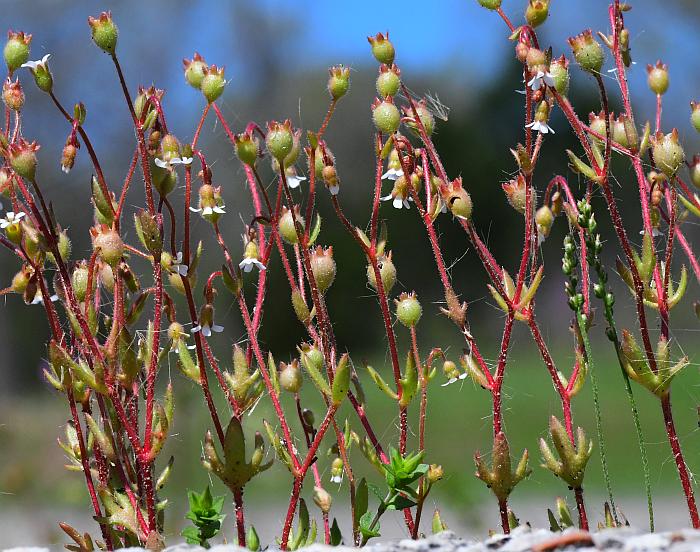Saxifraga tridactylites L.

Introduced
CC = *
CW =
MOC = 0
© SRTurner
Saxifraga tridactylites L. | |
 |
Introduced CC = * CW = MOC = 0 |
© SRTurner |
|
Family - Saxifragaceae Habit - Annual forb with small taproot, becoming red with age. Stems - Ascending to erect, to 15 cm, usually reddish, often multiple from base, often branched, moderately pubescent with gland-tipped hairs, viscid.
Leaves - Basal and alternate, mostly sessile. Basal leaves often wilted by flowering. Blades to 2 cm long, thick, fleshy and succulent when fresh, tending to be disposed in the lower half of the plant, the proximal half of the leaf tapering uniformly to a narrow base, the distal half expanded to 1 cm broad and divided into 3 parallel, elongate, narrow lobes, sometimes with 1-3 secondary lobes; leaves in the inflorescence becoming reduced to small, often entire, widely spaced bracts; the margins entire, the margins and surfaces stipitate-glandular.
Inflorescence - Open panicles or occasional solitary flowers, typically more than half the plant height, with alternate axillary flowers borne singly on slender erect pedicels to 2 cm long. Pedicels moderately stipitate-glandular. Flowers usually pendent on curved pedicels.
Flowers - Perfect (in Missouri plants). Calyx lobes erect, elliptic to ovate, margins and adaxial surfaces stipitate-glandular. Petals 5, white, entire, narrowly obovate to oblanceolate, 2.5-3 mm, longer than sepals. Stamens 10, slightly shorter than the petals, with subglobose anthers. Ovaries mostly inferior in flower, appearing less so in fruit. Styles 2, small, erect, basally united.
Fruits - Erect capsules to 5 x 4 mm. Seeds dark brown, 0.3-0.4 mm long, with longitudinal rows of minute blunt tubercles.
Flowering - April - May. Habitat - Rock crevices, sandy soil, pavement cracks, roadsides. Origin - Native to Eurasia. Lookalikes - Distantly, Androsace occidentalis. Other info. - This diminutive species was first reported for Missouri by Doug Ladd, in May 2019. At present it appears to be rare across the continental U.S., with occurrence reports limited to only a few states in the Northwest and Southeast. However, the tiny stature of the plant and its somewhat weedy aspect suggest that it may be vastly underreported, and it also appears to be rapidly increasing. The plant is recognized by its red, viscid-glandular stems, trilobate leaves, tiny white-petaled flowers, and roundish fruits. The plant prefers highly disturbed areas with little other vegetation, and sandy or rocky, calcareous substrate. The plants shown in the images above were growing in pavement cracks. Photographs taken at Meramec State Park, Franklin County, MO, 4-16-2020 (SRTurner). |